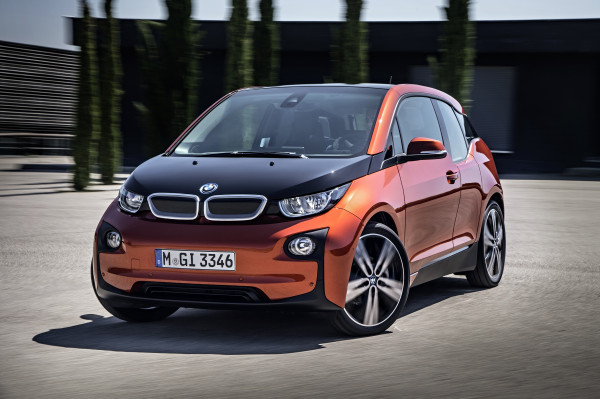BMW formally unveiled its first mass production electric car, the i3, today to a global audience. It is the first product of the German automaker’s i sub-brand of green cars, and will price for around $41,350 before tax rebates and the like. Release plans here in the United States are set for the second quarter of next year.
We’ve covered the i3 extensively before, noting just last week it getting priced and prior to that reviewing its detailed technical specifications. The electric vehicle as a concept has been around since before the i sub-brand came into being over two years ago, and was previously known as the Meagcity Vehicle as far back as at least 2010. It truly has been fascinating to follow the evolution of this electric car over the last three years.

Included below are the entire highlights of the i3 from BMW’s perspective. Whether or not the car is a game changer in the developing electric vehicle market remains to be seen, but it is certainly interesting to see that, among other things, the EV includes an optional range extender similar to that of the Volt. It seems as if BMW is hedging their bets a little bit to see what their more affluent drivers are truly after in a luxury environmental automobile.
BMW i3 Quick-Reference Highlights.
- Pricing (before federal or local incentives) starts at $41,350; $45,200 for Range Extender model. Destination & Handling Fee not included.
- On Sale: Q2 of 2014 in the USA.
- BMW’s 360 Electric electro mobility services.
- BMW i Remote app, which connects with the car.
- BMW Navigation is standard.
- BMW Intelligent Emergency Call (‘eCall”), Anti theft alarm and Rear Parking Distance Control are standard.
Driving.
- 170-hp, 184 lb-ft hybrid-synchronous electric motor with max. revs of 11,400 rpm.
- 80-100 mile real-world EV range.
- 22-kWh lithium-ion battery, which weighs 450 lbs.
- 650cc gasoline powered Range Extender optional; holds charge, doesn’t power wheels.
- 0-30mph in 3.5 seconds, 0-60mph in approximately 7.0 seconds (preliminary).
- Top speed of 93 mph, electronically limited to preserve efficiency.
- BMW’s signature, near-perfect 50-50 weight distribution.
- Ultra-tight turning radius (32.3 ft), which is ideal for city driving.
- Macpherson strut front and 5-link rear suspension set up.
- Single Pedal Driving Concept with Brake Energy Regeneration, which feeds power back into battery.
- 3 drive modes: Comfort, ECO PRO and ECO PRO+.
- 3 hour 220 V @32 amps charging time.
- Optional SAE DC Combo Fast Charging allows for 80% charge in 20mins; 100% in 30 mins.
Chassis and Body.
- Purpose built construction. World’s first mass-produced CFRP-constructed electric vehicle.
- Built on innovative LifeDrive architecture composed of two parts: Life Module and Drive Module.
- Life Module is essentially the cabin, constructed from Carbon Fiber Reinforced Plastic (CFRP).
- Drive Module is where all of the powertrain components are housed.
- Drive Module is made from 100% aluminum.
- Magnesium cross-member for instrument panel saves 20% weight vs. steel.
- BMW 1 Series external footprint with BMW 3 Series interior space.
- Adaptive Full LED headlights and LED taillights (standard in US market).
- Weighs in at roughly 2,700 lbs.
- No space-consuming transmission tunnel dividing car’s interior.
- Pillar-less design with rear coach doors allow for easy entry and exit to rear seats.
- Driver-oriented super-ergonomic controls.
- Three vehicle Worlds (trim levels): Mega (standard in US), Giga, and Tera.
- Standard 19-inch light alloy wheels with unique 155/70 all-season tires. 20-inch light alloy wheels optional.
- No transmission tunnel and low console allows for Slide-through Experience, which benefits urban driving by the ability to exit from the passenger side.
Sustainability.
- Made with sustainable, renewable materials.
- Instrument panel surround and door trim use fibers from Kenaf plant.
- Carbon fiber reinforced plastic (CFRP) roof panel is made partially with recycled CFRP from manufacturing process of other components
- 25% of plastic used in interior comprised of recycled materials.
- Dashboard wood trim crafted from responsibly-forested eucalyptus.
- CFRP components are sustainably produced in Moses Lake, WA, USA, where the factory uses hydroelectric power.
- The Leipzig, Germany assembly plant uses wind-generated electricity.
- Olive-leaf extract is used to tan interior leather surfaces.
“The BMW i3 is more than an evolutionary step,” said Dr. Norbert Reithofer, Chairman of the Board of Management of BMW, in a statement, “it is a great leap forward. From sketch to street, the i3 is unique in every respect. With the intention of creating a truly sustainable car, we conducted research in megacities around the world. This included millions of test miles with our retro-fitted electric cars, MINI E and BMW ActiveE; years of research in collaboration with Megacity experts around the world and thousands of hours talking with customers. From the start, we redesigned our entire development and production processes. The BMW i3 is purpose-built around an electric powertrain to serve the needs of our megacity customers.”